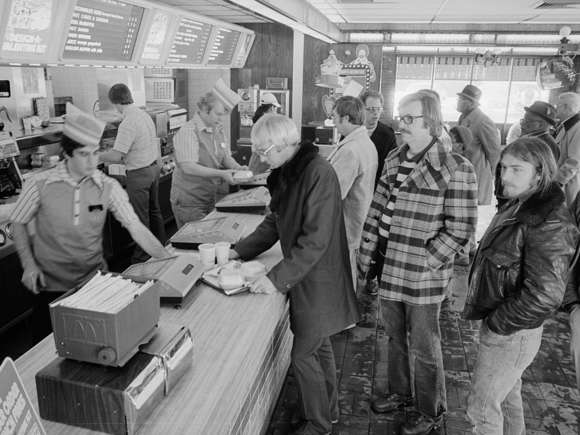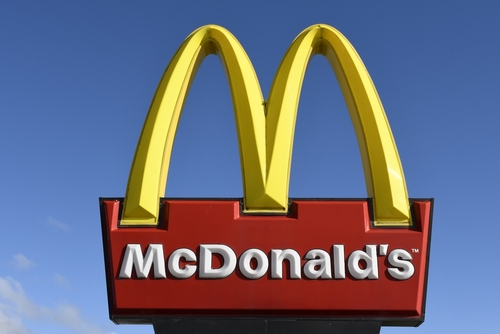McDonald’s in the 1970s wasn’t just a place to grab a quick meal—it was an experience. With bold colors, paper hats, and prices that seem unreal by today’s standards, every visit felt like a mini event. Whether you were a kid collecting character cups or a teen cruising in after school, the golden arches meant good times. These vintage photos give us a rare peek into what it really looked—and felt—like to eat at McDonald’s during its most charming era.
Vintage Photos Show What It Was Like to Eat at McDonald’s in the 1970s

The 1970s were a golden era for McDonald’s. The food was cheap, the vibe was fresh, and the design screamed retro charm. These vintage photos reveal how America’s favorite fast-food chain looked before the digital age—when hamburgers were 30 cents and the Hamburglar was still a new face on the block. Let’s step back in time to see what a visit to McDonald’s really felt like in the disco decade.
A Classic Golden Arches Welcome

In the 1970s, spotting a McDonald’s from the road was easy. The golden arches weren’t just a logo—they were part of the building. Many locations had two giant yellow arches running through the roof, a signature design that made them look more like space-age diners than fast-food joints. The signage was bold and straightforward, advertising prices like “15¢ HAMBURGERS” and “SHAKES 20¢.” These neon-lit signs buzzed through the night and drew families in like a beacon. Photos from the time show clean parking lots filled with classic cars, families walking in together, and big signs promising “FAST SERVICE.” It was a time before touchscreen menus or online orders. Customers looked up at giant boards behind the counter, scanned the limited but dependable menu, and placed their orders face-to-face. It felt personal and predictable—and that’s exactly what made it iconic.
Retro Menus and Simple Choices

Compared to today’s overwhelming menu boards, the 1970s McDonald’s menu was refreshingly simple. There were maybe a dozen items at most: hamburgers, cheeseburgers, fries, milkshakes, soft drinks, and the occasional Filet-O-Fish or Big Mac. That’s it. Breakfast wasn’t even a thing at most McDonald’s until the end of the decade, when the Egg McMuffin slowly rolled out. One of the most beloved parts of the 1970s McDonald’s experience was the consistency. A cheeseburger tasted the same no matter where you were. The fries were always salty and golden, served in a red paper sleeve. And if you were lucky, you got an apple pie fresh out of the fryer—crispy, bubbly, and dangerously hot. People didn’t come to experiment—they came for the comfort of the familiar.
Paper Hats and Brown Uniforms

Photos of McDonald’s workers from the 1970s paint a very different picture than today’s sleek polo shirts and visors. Back then, the standard uniform was all about brown and orange. Employees wore button-up shirts with pointed collars, polyester slacks, and thin aprons tied at the waist. Most notably, they topped it off with stiff paper hats—some with pinstripes, others plain white with golden arches printed on the front. These uniforms reflected the era’s no-nonsense attitude toward work. Employees were trained to deliver orders quickly, smile often, and always offer a polite “Thank you.” Most ordering happened at the front counter. There were no kiosks or mobile apps. You stood in line, spoke to a real person, and waited for your tray of hot food. The whole process was fast, but never rushed.
A Family-Friendly Hangout

In the 1970s, going to McDonald’s was an event—especially for kids. Families didn’t just swing through on their way home. They made a night of it. Some even dressed up, especially in smaller towns where McDonald’s was one of the few places open late. Parents sat with their kids in brightly colored booths, drinking coffee while the little ones sipped orange drink or slurped down milkshakes. Birthday parties were a huge deal. McDonald’s had a special party area in some locations, complete with paper hats, balloons, and trays loaded with cheeseburgers and fries. Sometimes, Ronald McDonald himself made appearances, posing for photos and performing little skits. For kids, these moments were magical. They got to eat fun food and meet real-life cartoon characters all in one place.
Ronald McDonald and the Gang Take Over

The 1970s was when the McDonaldland characters really took off. Ronald McDonald had already been introduced, but this decade brought along an entire crew: Grimace, Hamburglar, Captain Crook, Mayor McCheese, and others. These characters weren’t just background mascots—they were stars of commercials, toys, packaging, and even in-restaurant decor. Collectible glasses featuring the characters were popular giveaways. Kids begged their parents to collect the whole set, and many still have them today as vintage treasures. Ronald and friends also appeared on tray liners, burger wrappers, and Happy Meal-style boxes long before the actual Happy Meal debuted in 1979. It made every trip to McDonald’s feel like part of a bigger story—one where kids were the heroes and hamburgers were the prize.
Interiors with Loud Patterns and Bold Colors

Step inside a 1970s McDonald’s, and you’d be greeted by a blast of bright, busy colors. The walls often featured earth-tone tile mosaics or faux-wood paneling. The seating was simple but bold—red plastic booths, orange Formica tabletops, and arched metal chairs. Fluorescent lighting gave the whole place a clean, functional feel. Every element inside the restaurant reflected the decade’s love of sharp lines and strong color choices. Even the trash cans matched the aesthetic. Some locations had cheerful murals or Ronald McDonald-themed wall art to keep kids entertained. The overall atmosphere was warm and energetic—perfect for families, teens, and anyone craving a break from home-cooked meals.
Drive-In Culture Was Still King

Although McDonald’s was pivoting toward dine-in service in the 1970s, drive-ins were still part of its DNA. Many older locations featured walk-up windows where customers could place orders from outside. Teens loved this setup. They could park their cars, lean against the hoods, and hang out with friends while munching on fries and sipping sodas. Some restaurants had speakers similar to drive-in movie theaters. You’d pull up, place your order through a scratchy intercom, and then wait while a server brought it out to your car. It was casual and fun, a perfect fit for the growing car culture of the time. This era marked the slow transition toward the modern drive-thru, but in the ‘70s, the parking lot was still the social hub.
Packaging That Was Just Plain Cool

If you saved your McDonald’s packaging from the 1970s, you’d have a collector’s dream today. The wrappers, cups, and boxes from that era were designed with a lot more personality than today’s minimalist branding. Big Mac boxes came in thick paperboard clamshells with printed descriptions and slogans. Cups had colorful stripes and characters printed on them. Even napkins had Ronald’s face or trivia games. Kids loved the puzzle games on tray liners, which kept them busy while parents chatted. Everything about the packaging was designed to entertain, not just serve food. There was also far less concern about environmental impact back then, so foam containers and plastic straws were everywhere. It might not fly today, but back then, it was just part of the charm.
Prices That Feel Like a Dream Today

Perhaps the most jaw-dropping thing about these vintage photos is the prices. Imagine walking into a McDonald’s and paying 15 cents for a hamburger or 25 cents for a shake. Even a full Big Mac meal was under a dollar. Families of four could eat for less than five bucks. These weren’t sales or limited-time offers—this was just the standard cost of fast food in the 1970s. Large signs outside the restaurants proudly displayed these prices, making them hard to miss. Inflation hadn’t caught up yet, and minimum wage workers could still enjoy a meal out without blowing their paycheck. It wasn’t fancy, but it was accessible—and that made all the difference.
A Final Thought on Fast Food Nostalgia

Looking at vintage McDonald’s photos from the 1970s is like peeking into a time capsule of American life. The colors were louder, the menus were smaller, and the prices were almost too good to be true. But what really stands out is the feeling: families spending time together, kids being wowed by mascots, and communities gathering around a burger and fries. In a world before digital screens and food delivery apps, McDonald’s was a place where moments happened. These old photos aren’t just about food—they’re about memory. And maybe that’s why they still make us smile today.
Read More: 27 Fast-Food Orders That Totally Miss the Mark

